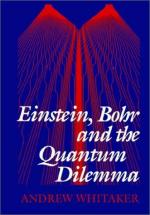|
This section contains 964 words (approx. 4 pages at 300 words per page) |

|
The Bohr theory or, more properly, the Bohr model of atomic structure was developed by Danish physicist and Nobel laureate Niels Bohr. Published in 1913, Bohr's model improved the classical atomic models of physicists Sir Joseph John Thomson and Ernest Rutherford by incorporating quantum theory. While working on his doctoral dissertation at Copenhagen University, Bohr studied German physicist Max Planck's quantum theory of radiation. After graduation Bohr worked in England with Thomson and subsequently with Rutherford. During this time Bohr developed his model of atomic structure.
Before Bohr, the classical model of the atom was similar to the Copernican model of the solar system, where, just as the planets orbit the Sun, electrically-negative electrons moved in orbits around a relatively massive, positively-charged nucleus.
The classical model of the atom allowed electrons to orbit at any distance from the nucleus. This predicted that when, for example, a hydrogen...
|
This section contains 964 words (approx. 4 pages at 300 words per page) |

|


